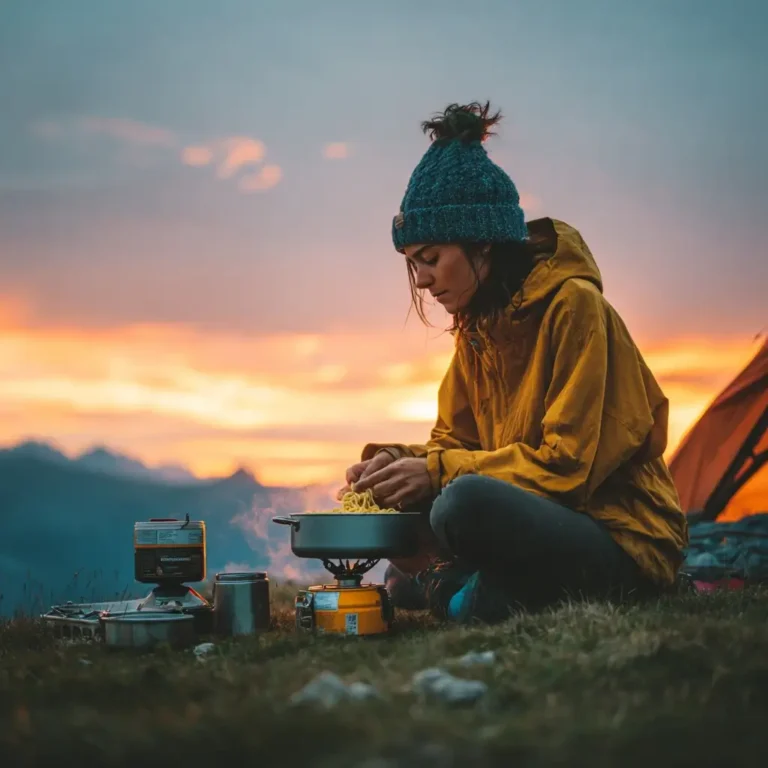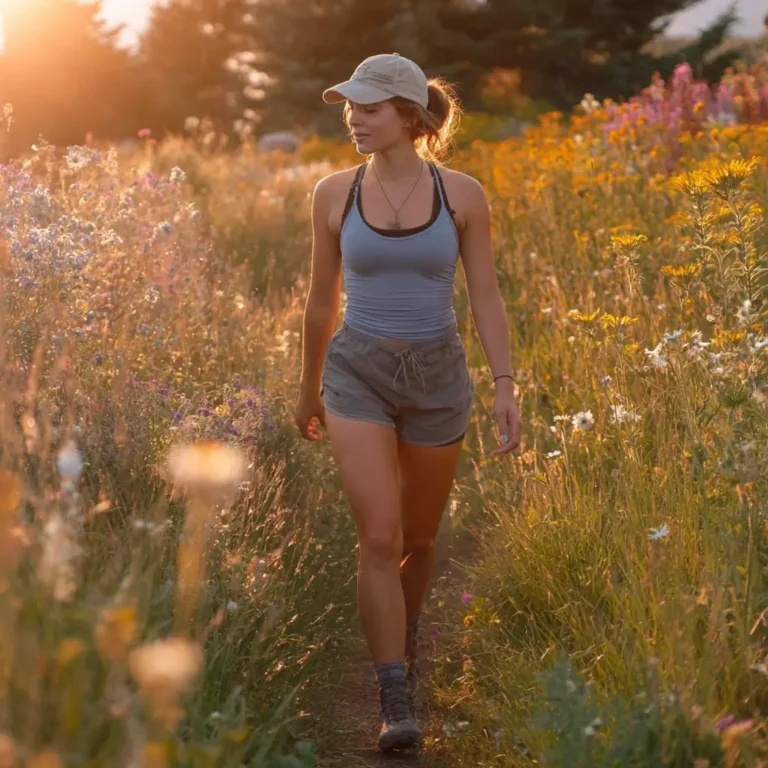Why Camping Essentials Matter (and Make Trips Magical)
If there’s one lesson we’ve learned after countless nights under the stars, it’s this: the right camping essentials turn a good trip into a great one. When your shelter goes up fast, your bed feels cozy, your kitchen runs like a diner, and your headlamp actually lights the trail to the loo—everything flows. You relax more. You laugh more. You sleep better. And you wake up stoked for sunrises, swims, and summits.
In this guide, we’ll walk through the systems that make camping awesome in the USA—from quick weekend car-camping to longer road trips. We’ll help you pick smart, durable gear that’s comfortable, safe, easy to use, and (bonus) fits your style and budget. Think of this as your camping essentials blueprint: shelter + sleep, kitchen, water, clothing and footwear, safety + lighting + navigation, comfort + organization, and wildlife & weather smarts. Sprinkle in our favorite pro tips and a few Amazon picks, and you’re ready to roll.
Shelter & Sleep: Your Cozy Basecamp
Your shelter and sleep system are the foundation of every great camp. Get these right, and the rest of your trip sings.
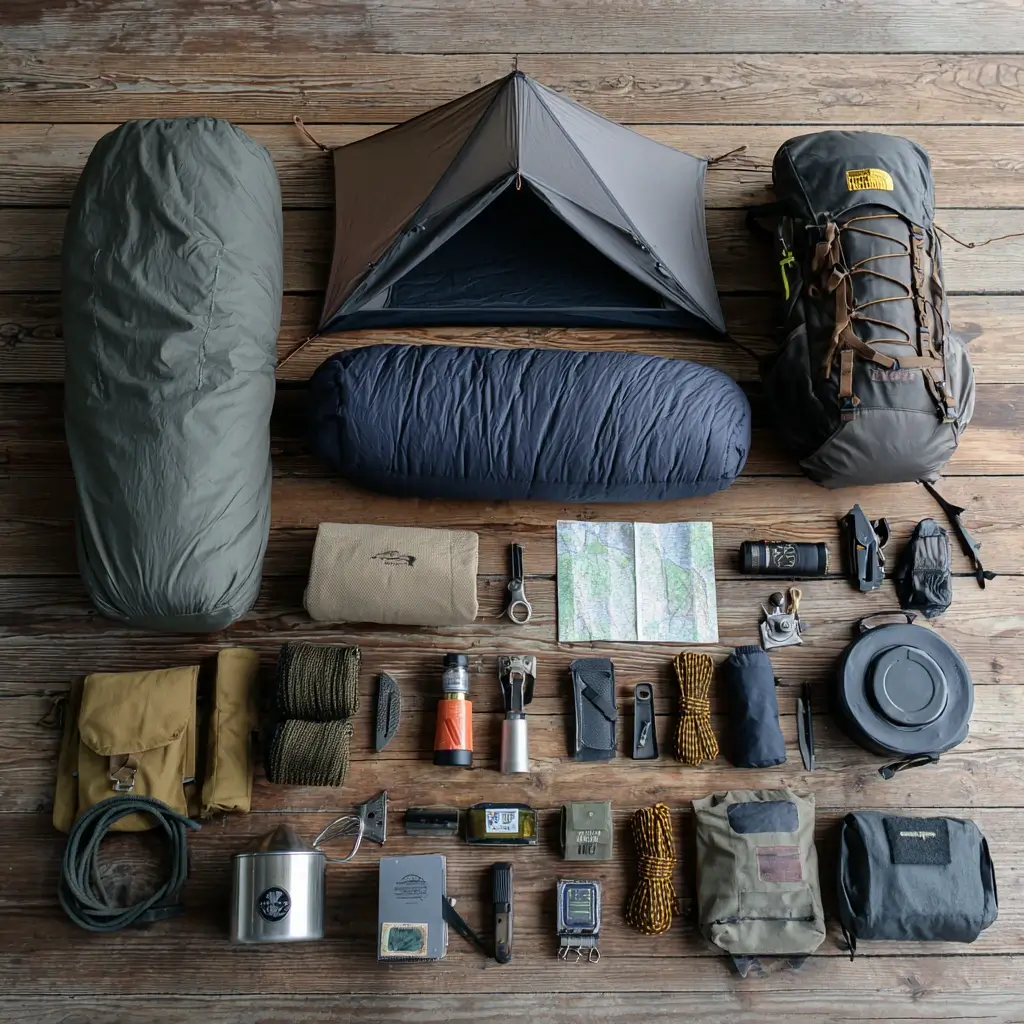
Tents: Size, Seasons, and Sanity
- Capacity: A “2-person” tent fits two sleeping pads edge-to-edge. If you like elbow room or bring a pup, consider sizing up (e.g., 3-person for two).
- Seasons: A 3-season tent is perfect for spring–fall in most of the USA—good ventilation, double-wall (inner mesh + rainfly), and strong enough for typical storms.
- Ventilation: Mesh panels + adjustable vents prevent condensation. In summer, nothing beats a breathable inner with the rainfly rolled back (weather permitting) for stargazing.
- Vestibules & doors: Dual doors stop the midnight crawl-over; vestibules keep muddy boots and packs dry.
- Setup: Freestanding tents pitch fast on hard ground; color-coded poles are your friend. Practice once at home!
Site selection: Choose a spot with natural shelter from wind, on durable ground, slightly elevated to avoid pooling if it rains. Clear sticks and cone “prickers” (your pads will thank you). Stake and guy-out your tent even if it’s calm—wind arrives uninvited.
Amazon Pick (Tent): We like the reliable Coleman Sundome 4 for roomy, budget-friendly car camping.
Sleeping Bags: Warmth Without the Bulk
- Temperature rating: Look for an EN/ISO comfort rating close to your coldest expected night. For shoulder seasons in much of the USA, 20–30°F works; for warm summer car-camping, 30–40°F is often plenty.
- Fill: Down is lighter and packs smaller; synthetic insulates better when damp and costs less.
- Shape: Mummy bags are warmest per ounce; rectangular bags feel spacious and can unzip flat like a quilt (clutch in hot nights).
Amazon Pick (Sleeping Bag): TETON Sports Celsius is a cozy, durable favorite for car-camping.
Sleeping Pads: R-Value = Real Sleep
- R-Value measures insulation from the ground (higher = warmer). For summer, R 2–3 is fine; shoulder season comfort improves with R 3–4+.
- Closed-cell foam pads (bombproof, light, budget) vs inflatable pads (thicker, comfier). Many campers stack a thin foam under an inflatable for puncture protection and warmth.
Amazon Pick (Pad): Therm-a-Rest Z Lite Sol is the classic, indestructible foam pad.
Pillows & Small Comforts
A tiny inflatable pillow or a stuff sack filled with a puffy makes a massive difference. Pack a sleep mask if camp is bright and earplugs for rowdy campgrounds.
Amazon Pick (Pillow): Trekology Aluft packs tiny and feels great.
Camp Kitchen: Fast, Delicious, Low-Mess
Dialing in your kitchen turns “just food” into a highlight.
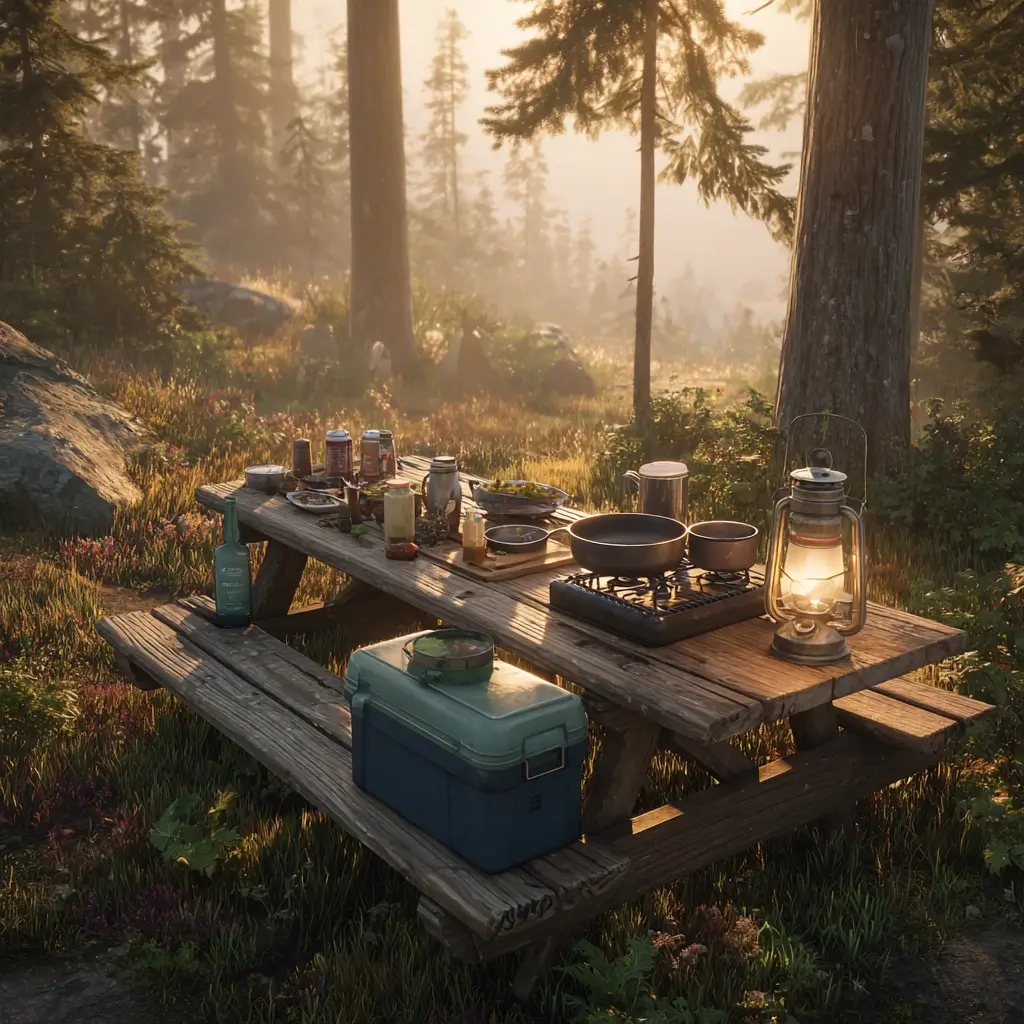
Stoves & Fuel
- Canister stoves (screw onto isobutane fuel) are light, fast, and easy—perfect for coffee, pasta, ramen, and one-pot meals.
- Two-burner camp stoves shine for car camping: pancakes + eggs at the same time, yes please.
- Wind kills boil times—bring a simple windscreen (where safe) and cook on a stable surface.
Amazon Pick (Backpacking Stove): MSR PocketRocket 2 is tiny, fast, and dependable.
Cookware & Utensils
- One-pot strategy reduces cleanup. A 2–3L pot + frying pan covers most meals.
- Materials: Aluminum heats fast and is affordable; stainless is durable; nonstick is beginner-friendly—use a silicone spatula.
- Bring a long spoon, knife, lighter/matches, cutting board, pot gripper, and coffee setup (French press insert, pour-over cone, or percolator—choose your ritual).
Amazon Pick (Cookset): GSI Outdoors Pinnacle Camper kit is a car-camp workhorse.
Coolers & Food Safety
- Keep raw meats sealed; store ice in block form or frozen water bottles (less mess).
- Use a cooler with good insulation; pre-chill it and keep it shaded under a table or tarp.
Amazon Pick (Cooler): Coleman Xtreme 70-Quart handles weekend feasts.
Cleanup: The “Three-Bin” Method
- Bin 1: hot soapy water, Bin 2: hot rinse, Bin 3: cold water with a few drops of sanitizer. Strain food bits; pack out scraps. Use biodegradable soap away from streams.
Amazon Pick (Soap): Campsuds is a tiny bottle that lasts forever.
Pro tip: Pre-chop and pre-spice at home. You’ll cook faster and clean less.
Water & Hydration: Simple, Safe, and Plenty
If you remember only one thing: bring more water than you think you need—especially in summer heat or high altitude.
How Much Water?
- For relaxed car-camping days: 1–2 gallons per person per day covers drinking, cooking, and basic wash-up.
- On hikes: plan 0.5–1 liter per hour depending on heat and effort. Add electrolytes to avoid the bonk.
Treatment Options
- Filters (like squeeze or pump) remove bacteria/protozoa.
- Chemical drops/tablets (AquaMira, iodine) are ultralight backups; watch the wait time.
- UV sticks (like SteriPEN) treat quickly in clear water.
Amazon Pick (Filter): Sawyer Squeeze is fast, light, and field-proven.
Bottles, Bladders & Storage
- Nalgene 32-oz bottles are indestructible and great for hot drinks on cold nights.
- Hydration bladders keep you sipping all day without stopping.
- Collapsible jugs store camp water and pack flat on the way home.
Amazon Picks:
Pro tip: Mark one “dirty” hand and one “clean” hand when filtering to avoid cross-contamination on the trail.
Clothing & Footwear: The Right Layers for the Forecast
We dress in systems: moisture-wicking base, insulating midlayer (if needed), and a weather-proof outer. Even in summer, nights can get chilly in the mountains or deserts.
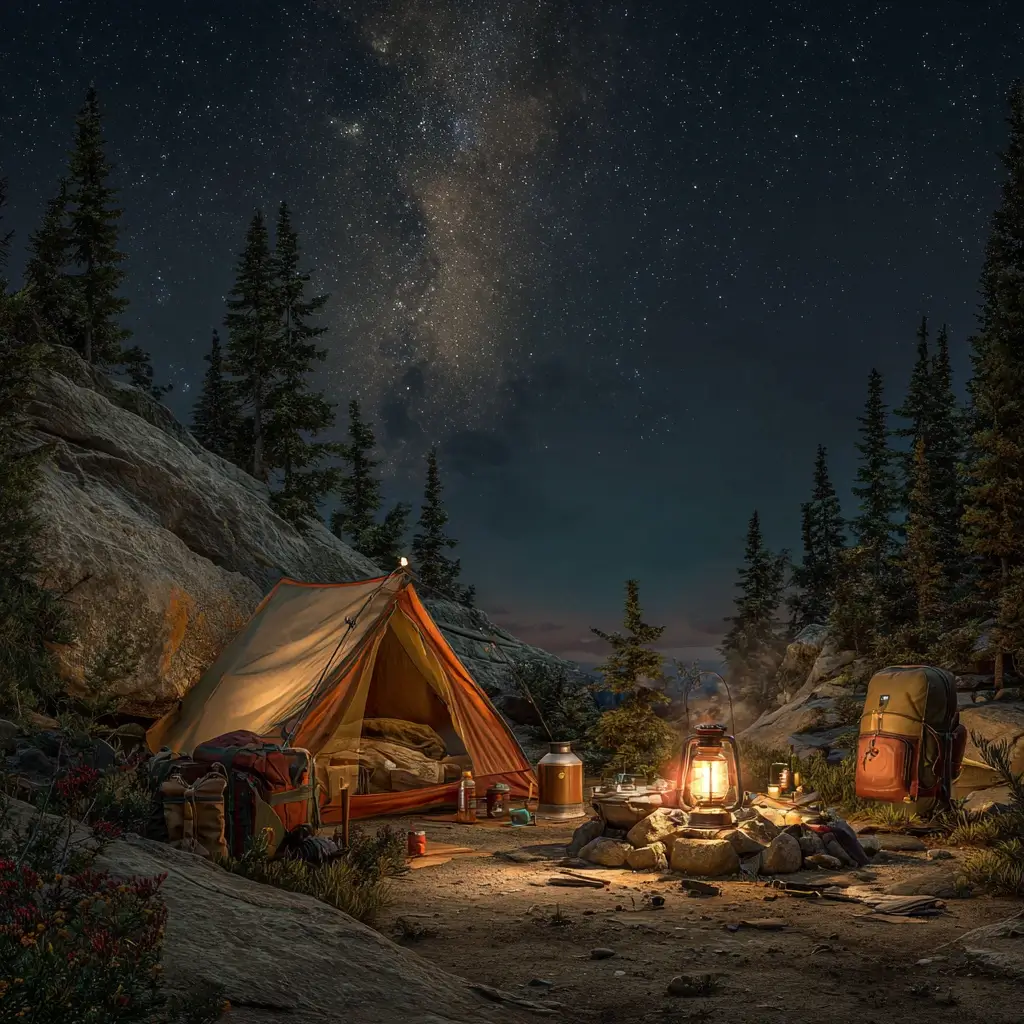
Fabrics & Layers
- Base: polyester/nylon or ultralight merino (no cotton).
- Insulation: fleece or light puffy for shoulder seasons.
- Shell: a packable rain jacket blocks wind and surprise showers.
- Sun armor: UPF shirts, wide-brim hats, and sunglasses for long, exposed days.
Footwear & Socks
- Hiking shoes or trail runners for most U.S. park trails; boots for heavy loads or rough talus.
- Socks matter: merino or synthetic to wick sweat and prevent blisters. Bring a dry camp pair to change into at night.
Camp Comfort
- Slip-on camp shoes (light sandals or slides) give feet a breather. A cozy beanie and puffy make star-gazing comfy even in summer at altitude.
Amazon Tip (Rain Layer): Columbia Arcadia II (Women) / Watertight II (Men) are popular, packable shells—search the model that fits your style and size.
Sunscreen (SPF 30+), SPF lip balm, and bug repellent live in our daypack hip pocket all season.
Safety, Navigation & Lighting: Small Items, Big Peace of Mind
These aren’t glamorous, but they’re true camping essentials that keep us safe and smiling.
Lighting
- Headlamp = hands-free everything (cooking, tent setup, late-night trail runs to the restroom). Bring spare batteries or a USB-rechargeable model.
- A small lantern turns your picnic table into a cozy kitchen and game space.
Amazon Picks:
- GearLight LED Headlamp (2-Pack): bright, simple, great value.
- Vont LED Lantern (2-Pack): compact and bright.
First Aid & Repair
- Bring a first-aid kit sized for your group and trip length—add personal meds, extra blister care, and antihistamines if you’re allergy-prone.
- A multi-tool, tenacious/reinforced tape, cordage, and spare stakes handle gear surprises.
Amazon Picks:
Navigation & Power
- Paper map + compass never run out of battery (learn a couple basics).
- Bring a power bank for phones, headlamps, and lanterns—especially if you shoot lots of photos.
Amazon Pick (Power): Anker PowerCore 10000 is tiny and reliable.
Pro tip: Screenshot offline maps (and download in your nav app) before you lose service.
Comfort & Organization: The Secret Sauce
Comfort gear doesn’t just pamper—it keeps camp smooth, cheerful, and stress-free.
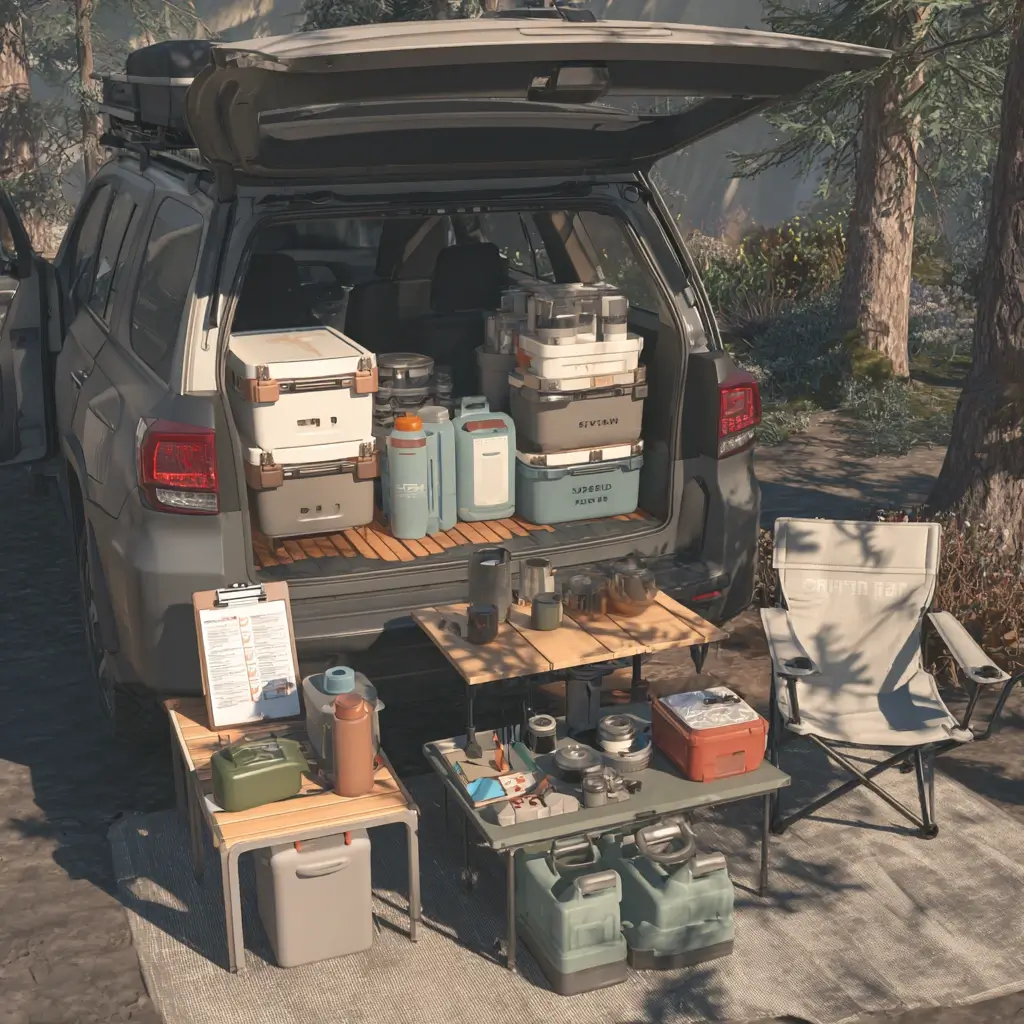
Sit, Sip, and Settle In
- Camp chairs turn the fire ring into a living room.
- A little roll-top table makes food prep and card games easy.
- Add a doormat or old towel at the tent door to keep grit out of your sleeping space.
Amazon Picks:
- Trekology YIZI GO Chair (packs small, sits comfy)
- Trekology Portable Camping Table
Tarps, Ropes & Dry Bags
- A simple tarp + paracord rig becomes instant shade or rain shelter over the table.
- Dry bags stash clothes, matches, and electronics—dustproof by day, dew-proof by night.
Amazon Pick (Dry Bag): Sea to Summit Lightweight Dry Sack
Clean & Fresh(ish)
- Biodegradable wipes, hand sanitizer, and a compact towel keep everyone happy.
- For places without facilities, a trowel + TP (packed out!) + zip bag keeps your site pristine.
Amazon Pick (Trowel): TheTentLab Deuce #2 is ultralight and mighty.
Smart Storage
- Use a couple stackable bins: “Kitchen,” “Sleep,” and “Misc/Repair.” Label them.
- Keep a ready-to-go toiletry pouch in one bin so you never forget a toothbrush or contacts.
Pro tip: Toss a tiny whisk broom in your bin. Two swipes = crumb-free picnic table and a cleaner tent floor.
Leave No Trace, Wildlife & Weather Smarts (Plus a Quick Checklist)
The places we love only stay wild if we treat them right. Build these habits into your camping essentials mindset:
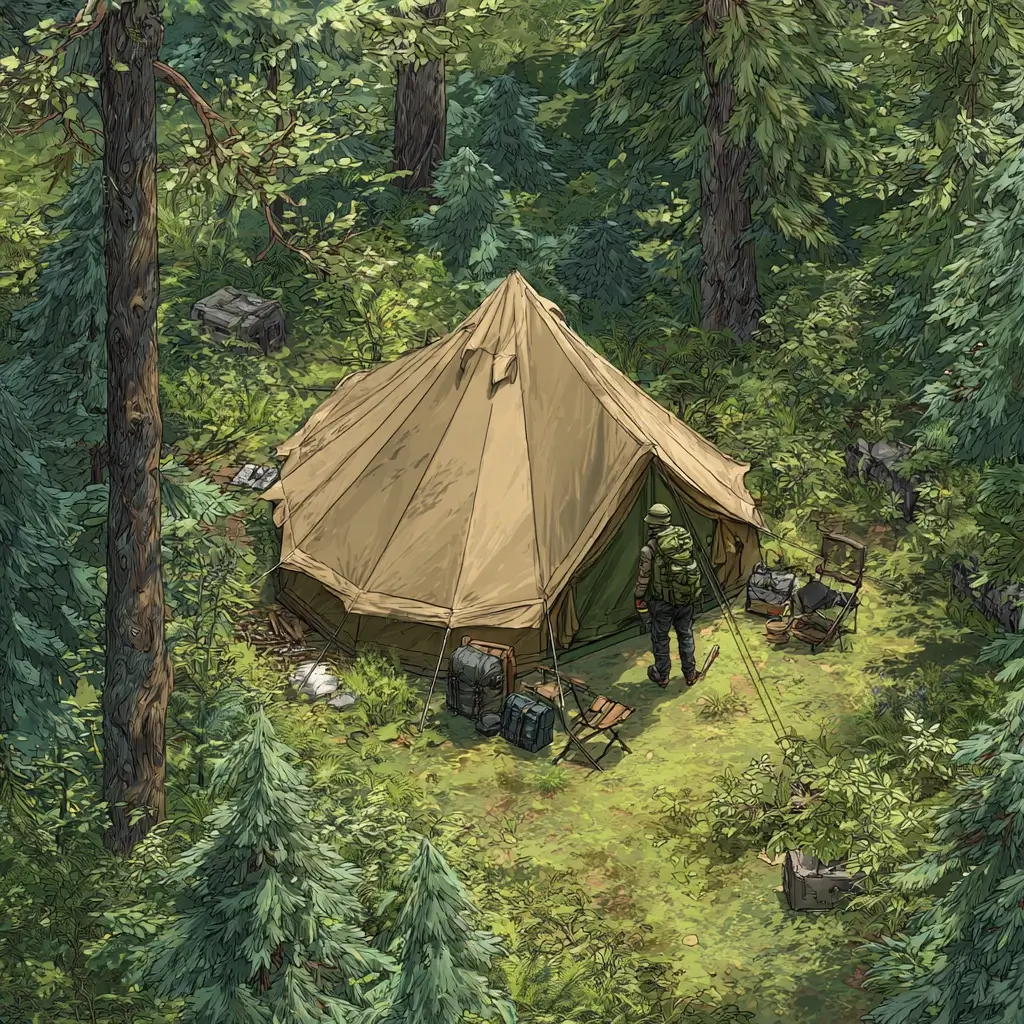
Leave No Trace (LNT) Quick Hit
- Plan ahead (permits, fire restrictions, bear rules).
- Travel & camp on durable surfaces (existing sites).
- Dispose of waste properly (pack out trash; follow local rules for human waste).
- Leave what you find (photos yes, antlers no).
- Minimize campfire impacts (existing rings; drown, stir, and feel for heat = out).
- Respect wildlife (give space; never feed).
- Be considerate of others (sound carries—especially at night).
Wildlife-Wise Food Storage
- In bear country, use bear canisters where required or proper hangs where allowed. At car campgrounds, stash all food and toiletries in your car or bear box—never in your tent.
Amazon Pick (Bear Storage): BearVault BV450 (weekend size).
Weather & Forecast Strategy
- Check weather twice: before you go and the morning of departure.
- Pack a dry bag for spare layers and a wind/rain shell even on sunny forecasts—mountains and coastlines flip the script fast.
- In heat, set alarms for water breaks; in chill, keep dry socks and a warm layer handy.
Quick “Camping Essentials” Checklist ✅
- Kitchen: Stove + fuel, lighter/matches, pot/pan, utensils, mug, cutting board, coffee gear, cooler & ice, soap + scrubber, dish bins, trash bags
- Water: Full bottles, camp jug, filter/treatment, electrolytes
- Clothing: Wicking base layers, insulating layer (seasonal), rain shell, hat, sunglasses, socks, camp shoes
- Safety & Tools: Headlamp/lantern + batteries, first-aid kit, multi-tool, repair tape, map/compass, power bank
- Comfort & Hygiene: Chairs, table, tarp/cord, dry bags, wipes/sanitizer, towel, trowel + TP (pack out), toiletries
- Wildlife & Weather: Bear canister/box plan, sunscreen, bug repellent, current forecast
- Shelter & Sleep: Tent + stakes/guylines, footprint/tarp, sleeping bags, pads, pillows
Our Experience with Camping Essentials 🏕️
Over the years, our “camping essentials” kit has gone from a chaotic jumble to a dialed system that practically sets itself up. We learned the hard way that the right shelter and sleep setup changes everything—one windy desert night with a flimsy tent and flat pad taught us to prioritize sturdy poles, full guylines, and an insulated sleeping pad with a real R-value. Our kitchen evolved too: a reliable two-burner stove, a single nonstick pan, and a tiny spice kit turned camp dinners from “meh” to memorable. Water management was another breakthrough; carrying a collapsible jug and a squeeze filter keeps us hydrated without constant runs to the spigot. The unsung heroes? Headlamps (with fresh batteries!), a compact first-aid kit beefed up with blister care, and a small repair pouch with tape, zip ties, and a multi-tool—those have saved more trips than we can count. We now pack a tarp for shade, a couple of lightweight chairs, and dry bags to corral clothes and electronics. Add sunscreen, bug repellent, and a printed checklist, and the whole experience becomes smoother, safer, and way more fun. When the essentials are covered, we can focus on the good stuff—stars, stories, and s’mores.
Our Tips for Camping Essentials 🏕️
- Do a backyard shakedown Pitch the tent, inflate pads, fire up the stove, and test headlamps at home—fix surprises before you’re miles from a store.
- Pack in labeled bins Use three totes: Shelter/Sleep, Kitchen/Food, Tools/Safety. Add a simple checklist inside each lid for fast pack-out.
- Prioritize sleep comfort Match bag temp rating to the coldest night and choose a pad with the right R-value (R 2–3 summer, 3–4+ shoulder seasons). Bring a pillow—tiny weight, huge payoff.
- Keep the kitchen simple One-pot meals, a 2–3L pot, nonstick pan, long spoon, lighter, and a tiny spice kit. Pre-chop and pre-marinate at home to cut mess and time.
- Water plan = trip plan Carry a camp jug, personal bottles/bladder, and a filter/tabs. Aim for 1–2 gal/person/day in camp; add electrolytes in heat.
- Redundancy for the “musts” Two fire sources (lighter + matches), two lights (headlamp + lantern), and a backup way to navigate (map/compass + phone GPS).
- Customize first aid & repair Start with a base kit, then add blister care, personal meds, antihistamines, tape, zip ties, sewing needle, and a multi-tool.
- Dial clothing by system Wicking base, warm midlayer, wind/rain shell. Pack dry camp socks and easy slip-on camp shoes; stash hat, sunglasses, sunscreen, bug repellent.
- Tarp + cord = comfort multiplier A simple tarp creates shade or rain cover over the table; add a doormat/towel at the tent door to keep grit out of your sleep system.
- Wildlife & Leave No Trace Know local food-storage rules (bear box/canister), pack out trash, strain dishwater, and camp on durable sites—good habits protect wild places for your next trip.
FAQ – Camping Essentials
What are the 10 essentials when camping?
The classic “10 Essentials” are: navigation (map/compass/GPS), headlamp, sun protection, first aid, knife/repair kit, fire (matches/lighter), shelter (emergency bivy/tarp), extra food, extra water, and extra clothing. Pack them every trip for safety, even on easy outings.
What are things needed for camping?
Think in systems: shelter & sleep (tent, bag, pad), kitchen (stove, fuel, pot/pan, utensils), water (bottles, filter, camp jug), clothing layers (base/mid/shell), lighting (headlamp/lantern), and safety (first aid, multi-tool, repair tape). Add navigation (map/compass), hygiene (soap, wipes, trowel), and comfort (chairs, tarp, cooler) to match your destination and season.
What are the 7 C’s of camping?
Often taught as etiquette and safety principles: Courtesy, Consideration, Cleanliness, Cooperation, Conservation, Caution (Carefulness), and Common Sense. Together they encourage respecting others and the environment, keeping camps tidy and safe, and making smart choices outdoors.
Final Campfire Thoughts 🔥
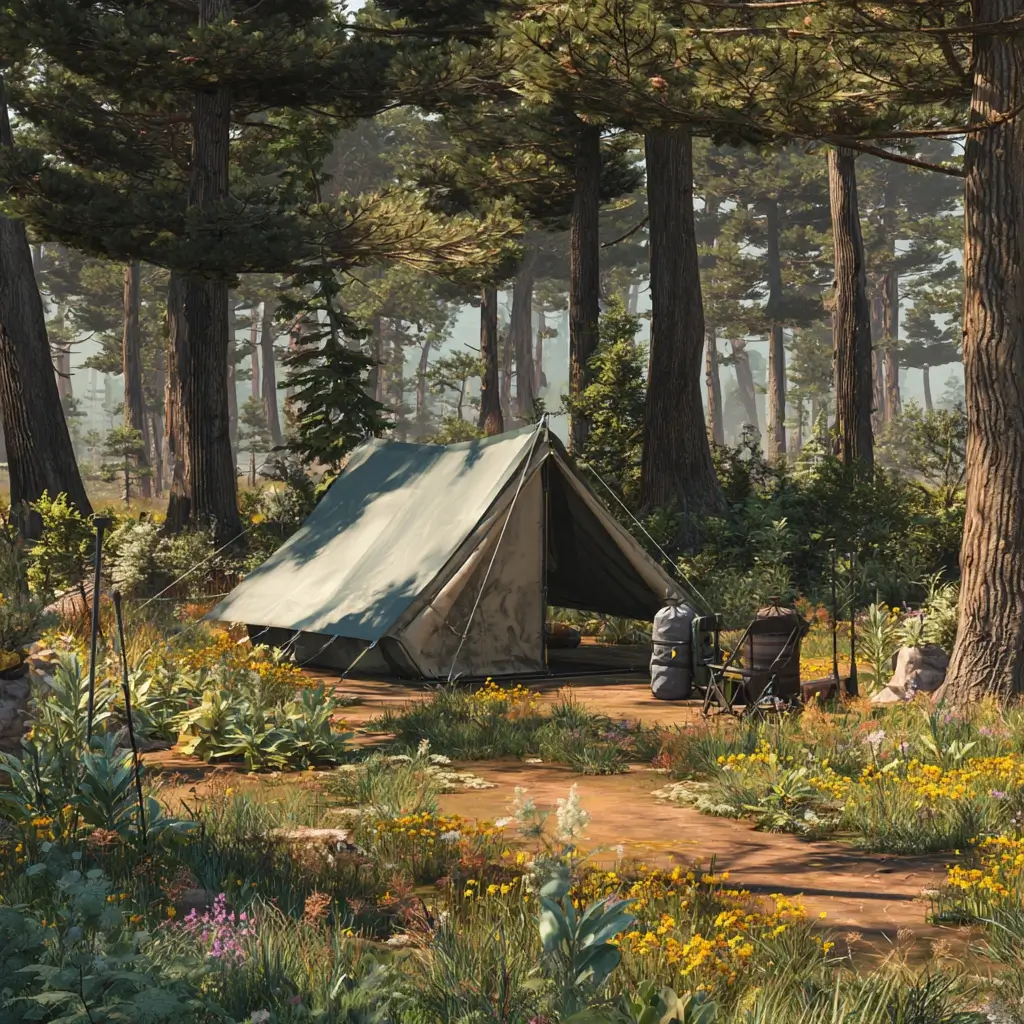
Great trips don’t happen by accident—they’re built on smart, simple camping essentials that keep everyone comfortable, safe, and smiling. Start with solid shelter and sleep, add a fuss-free kitchen and clean water plan, layer in the right clothing, and back it up with lighting, first aid, and a few comfort extras. Respect the land, store food wisely, and you’ll be welcomed back by wild places again and again.
Got questions or want a printable version of this checklist? Say the word, and we’ll whip one up for you. Now load those bins, cue your road-trip playlist, and let’s make some s’more-filled memories. 🌙✨
If you enjoyed this post, you might also love our article on Campfire Feast: 25 Epic Camping Dinner Ideas.
If you enjoyed this blog post about camping essentials, we’d love to hear from you! Leave a comment below and share your favorite winter hiking looks or tips.



